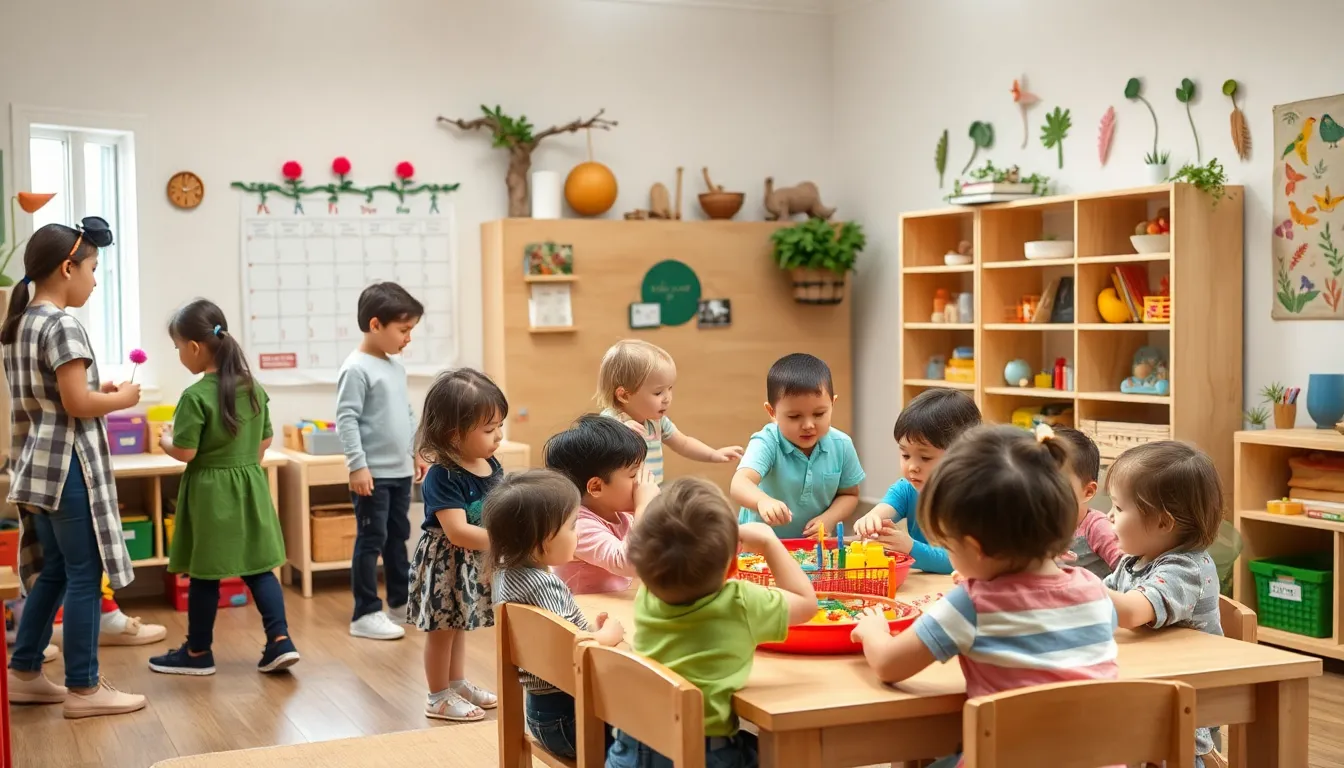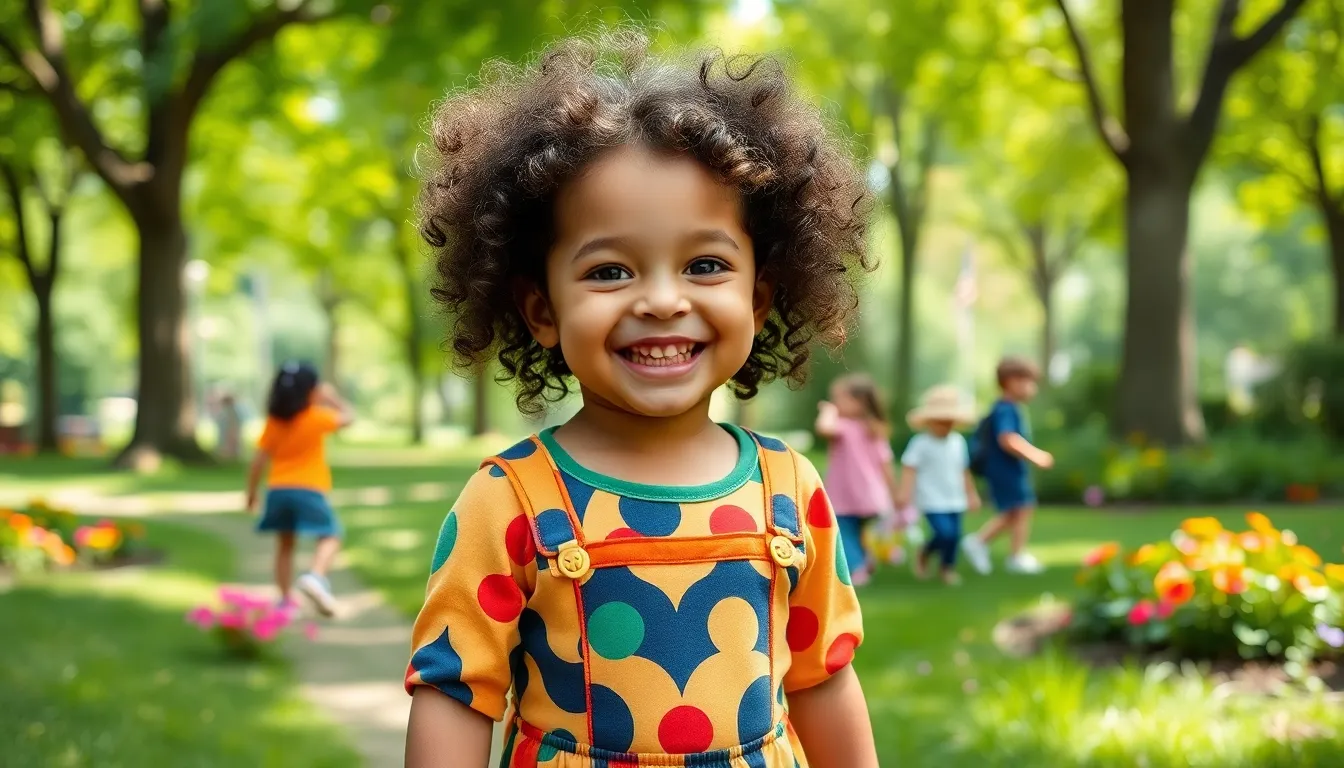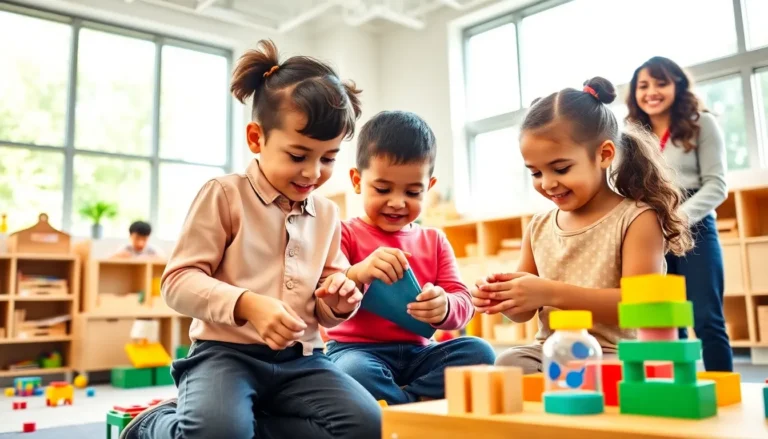Transitioning from one activity to another can feel like herding cats, especially in a Montessori setting. But fear not! Montessori transition activities are here to save the day, making those shifts smoother than a buttered slide. These activities not only keep kids engaged but also help them develop essential skills while having a blast.
Table of Contents
ToggleOverview of Montessori Transition Activities
Montessori transition activities play a crucial role in enhancing children’s ability to shift focus between tasks. Engaging activities hold a child’s attention while fostering essential skills such as patience and cooperation. Tools like transition songs or visual schedules provide cues that support movement from one task to another.
Incorporating physical movement, transition activities encourage children to expel excess energy and prepare mentally for new challenges. Activities like nature walks or scavenger hunts stimulate curiosity while facilitating smooth transitions. These interactive experiences promote exploration, allowing children to learn through play.
Fostering a sense of routine contributes to a child’s comfort during transitions. Implementing consistent practices, such as a designated signal for moving on, helps create predictability. When children understand what comes next, anxiety decreases, making transitions less daunting.
Art projects serve as another valuable way to ease transitions. Engaging with creative materials can serve as a bridge between activities, fostering focus and providing a tactile outlet. Children might transition from free play to structured learning situations seamlessly when integrated art experiences catch their attention.
Providing opportunities for peer interaction establishes social skills during transitions as well. Children learn to communicate and negotiate with each other, building confidence in group settings. Collaborative activities like group games or shared projects enhance teamwork and strengthen relationships.
Finally, mindfulness practices like deep breathing or yoga can ensure emotional readiness during transitions. These practices help children ground themselves and approach new activities calmly. Adopting techniques that enhance awareness cultivates resilience and adaptability in a fast-paced environment.
Importance of Transition Activities

Transition activities play a critical role in supporting children’s ability to navigate changes in their environment. These activities help reduce anxiety and bolster excitement as children shift from one task to another.
Benefits for Children
Engaging in transition activities fosters emotional regulation as children learn to manage their feelings during change. These activities provide a structured approach, guiding children toward readiness for new challenges. Social skills also flourish when children participate in collaborative activities, promoting teamwork and communication. Additionally, mindfulness practices cultivate resilience, enabling children to approach transitions with calmness and confidence.
Role in Montessori Education
Transition activities align with Montessori principles by emphasizing independence and self-directed learning. They encourage children to take ownership of their experiences. Such activities promote a sense of community and help establish routines, essential factors in Montessori education. Implementing visual schedules enhances predictability. Movement-based activities support physical development and encourage children to engage with their surroundings actively. Through mindful transitions, children gain the skills they require to thrive in diverse learning settings.
Types of Montessori Transition Activities
Montessori transition activities encompass various engaging strategies. These activities align with children’s developmental needs, facilitating smooth changes between tasks.
Physical Activities
Physical activities promote movement during transitions. Examples include nature walks and scavenger hunts that allow children to expend energy. Engaging in these activities prepares them mentally for new challenges. Running or playing tag can enhance their focus when approaching new tasks. Different forms of physical movement enable children to develop coordination and confidence. Adding variations to routine activities maintains interest while promoting well-being. Creating opportunities for physical expression contributes to an energized learning environment.
Sensory Activities
Sensory activities enrich the transition process through hands-on experiences. Activities like sensory bins filled with rice or beans provide tactile stimulation. Young learners can benefit from exploring different textures while transitioning. Incorporating colors and scents into activities fosters connection with their environment. Using materials such as playdough or water provides additional sensory engagement. Implementing sensory-rich experiences contributes to emotional regulation during changes and enhances concentration. Children develop critical thinking as they interact with various sensory elements.
Social and Emotional Activities
Social and emotional activities help children navigate transitions more effectively. Group activities encourage peer collaboration and communication. Sharing experiences during transitions fosters social skills such as empathy. Implementing role-playing scenarios prepares them for future interactions. Additionally, mindfulness practices, including deep breathing or yoga, support emotional readiness. Encouraging children to express feelings promotes emotional intelligence and resilience. Creating an environment for peer interaction enriches the transitions, ensuring children feel supported in their learning journeys.
Implementing Montessori Transition Activities
Effective implementation of Montessori transition activities enhances children’s adaptability and focus during changes. These activities align with Montessori principles, promoting independence and self-directed learning.
Creating a Transition Plan
Establishing a transition plan is crucial for seamless activity shifts. Begin by identifying key moments throughout the day when transitions occur. Incorporate transitional activities, such as singing transition songs or utilizing visual schedules, to provide children with cues. Schedule regular reviews of this plan to ensure its effectiveness, making necessary adjustments based on children’s responses. By doing so, the environment becomes predictable, reducing anxiety.
Engaging Parents and Caregivers
Engagement from parents and caregivers plays a vital role in the transition process. Provide resources and training sessions that outline the rationale behind specific activities. Share strategies, like using visual aids or songs at home, that reinforce the transition routine. Encourage caregivers to model patience and understanding during transitions, fostering a supportive atmosphere. Utilizing communication tools, such as newsletters or meetings, strengthens the connection between home and school, ensuring a cohesive approach to transitions.
Challenges and Considerations
Transitioning between activities in a Montessori environment presents several challenges. Children often resist changes, leading to heightened anxiety or frustration. To support smoother transitions, teachers can implement tailored solutions that cater to individual needs.
Emotional readiness plays a critical role in easing these challenges. Mindfulness practices, such as deep breathing or yoga, can significantly enhance emotional regulation, allowing children to approach new tasks with calmness. Engaging in sensory-rich experiences provides children with outlets for focus and connection during transition times.
Social interactions are another essential aspect to consider. Collaborative activities help children build confidence and develop teamwork skills. Group projects and role-playing scenarios not only foster empathy but also bolster communication abilities among peers.
Consistency also cannot be overlooked. Establishing a routine significantly contributes to children’s comfort levels during transitions. Visual schedules and transition songs offer predictable cues, making it easier for children to anticipate changes.
Parent and caregiver involvement is crucial throughout this process. Educating them about the significance of transition activities allows for reinforcement of these strategies at home. Sharing practical tools and tips can ensure a cohesive approach that supports children’s development.
Regular assessments of the transition plan are necessary to ensure ongoing effectiveness. Adapting strategies based on children’s responses keeps the approach relevant and impactful. Transition activities must remain flexible to accommodate different learning styles and individual preferences, promoting overall success in navigating changes.
Montessori transition activities play a vital role in helping children navigate the often-challenging shifts between tasks. By incorporating engaging and structured activities, caregivers can foster a sense of routine that enhances emotional regulation and reduces anxiety. These activities not only support children’s focus and coordination but also encourage social interactions that build confidence and teamwork skills.
The involvement of parents and caregivers is essential in creating a cohesive approach to transitions. By understanding and reinforcing these practices at home, they can help children thrive in diverse learning environments. Ultimately, implementing effective transition strategies paves the way for a more seamless and enjoyable learning experience, empowering children to embrace change with resilience and excitement.




